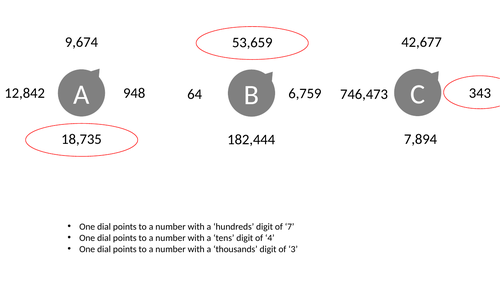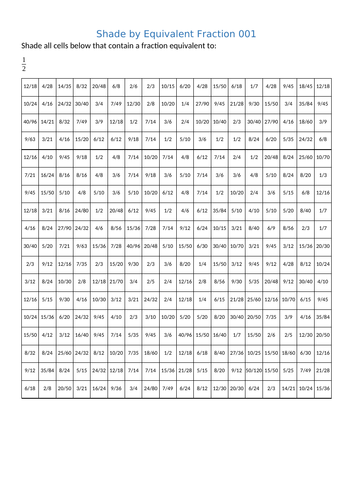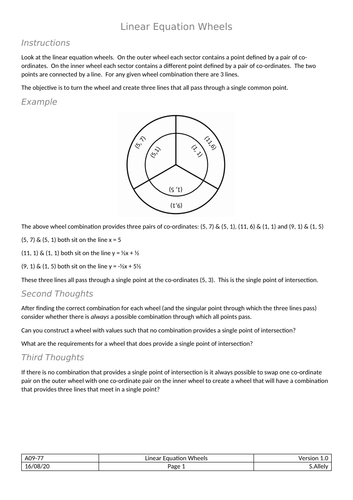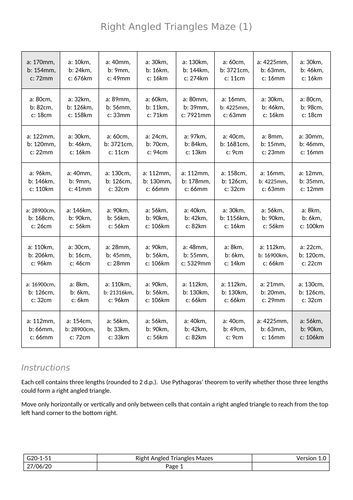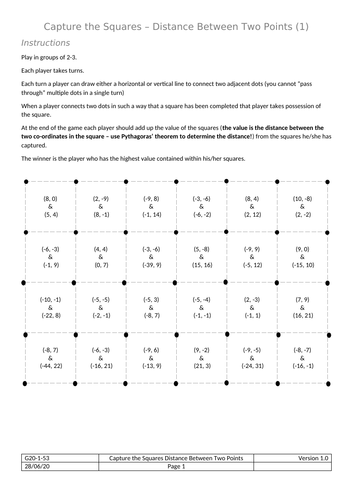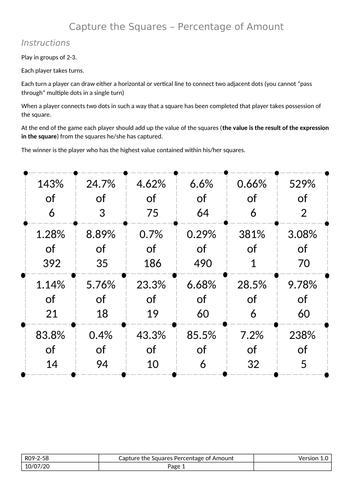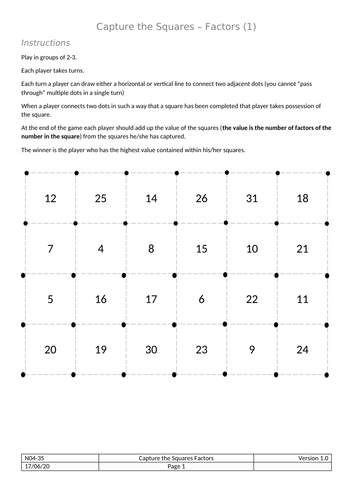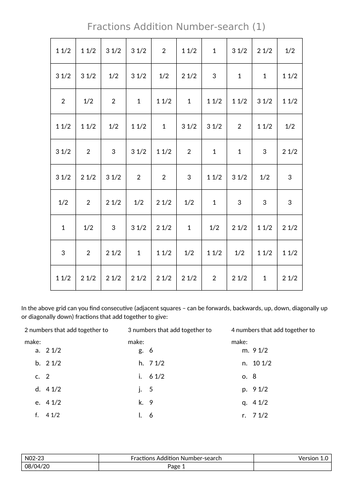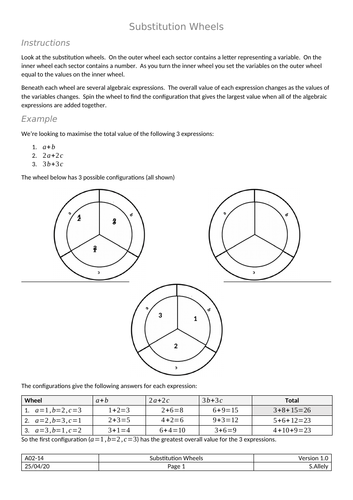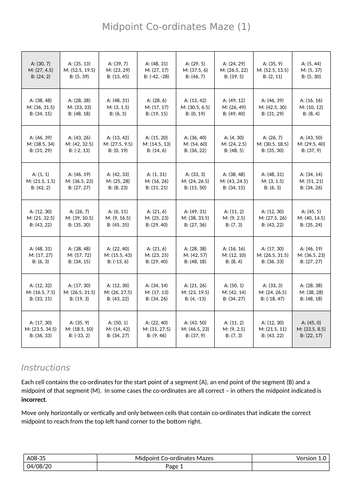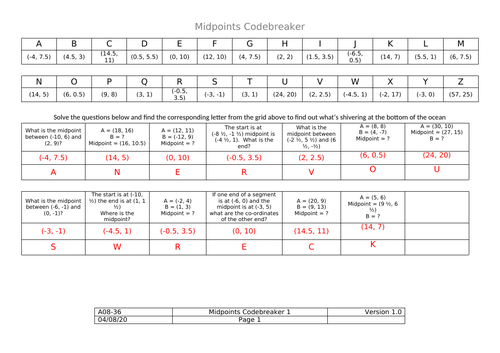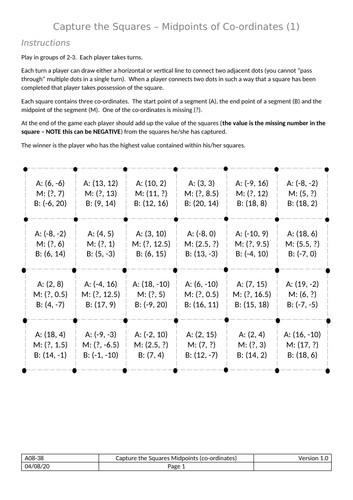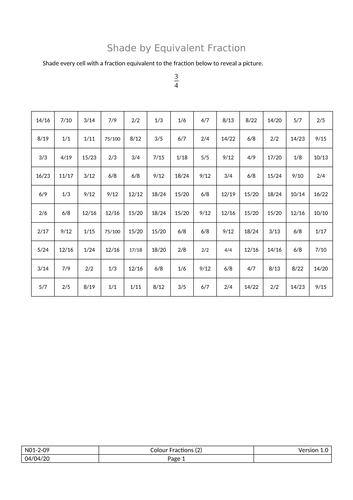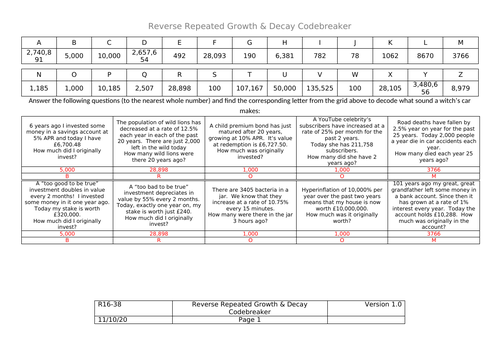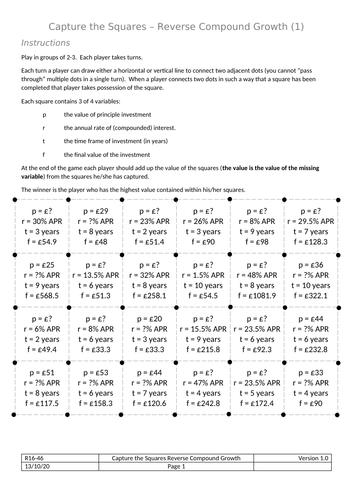
59Uploads
10k+Views
10k+Downloads

Multiplication Mazes
Move from square to square - only if the equation within is true. Find the path through from the top left hand corner to the bottom right.
Incorrect equations are mostly the result of misconceptions in implementing grid method (although some are misconceptions from column method).

Colour by Distance Between Co-Ordinates
Each segment contains two co-ordinate pairs. Work out the distance between the two using Pythagoras’ theorem and colour the segment according to this distance.
The resource does allow for co-ordinates in all 4 quadrants and may therefore challenge foundation level students but all triangles are Pythagorean triples with integer value lengths for the hypotenuse.

Right Angled Triangles Mazes
Use Pythagoras’ theorem to verify whether 3 lengths can form a right angled triangle.
Move through each maze from cell to cell - only if the cell contains lengths that would form a right angled triangle.
Labelling conventions of sides used are random (c is not always the hypotenuse). Incorrect cells are designed to highlight common misconceptions in the application of Pythagoras’ theorem.

Capture the Squares Distance Between Co-Ordinates
A couple of ‘capture the squares’ games where the square value is the distance between the two co-ordinates within the square (to be calculated using Pythagoras’ theorem).
Can be used to consolidate learning or as bell work.
Both games feature co-ordinates in all 4 quadrants. The first game has only integer co-ordinates and basic Pythagorean triple triangles. The second game still uses only basic Pythagorean triples but some are scaled to half or 3/2 and some of the co-ordinates may be decimal.

Colour by Number of Factors
Colour each segment of the picture according to how many factors the number contained within the segment has.
Suitable for lower ability groups or as light relaxing revision of the topic.

Capture the Squares Percentage of Amount
Capture the squares is a game intended for 2-3 players. Each takes turns drawing a horizontal or vertical line. When the fourth line around a square is drawn on the page, the player who placed that line takes the square.
Within each square there is a percentage of amount expression. The result of this expression is the value of the square taken (not all squares are of equal value).
The percentage of amounts in this particular game are designed to be calculated using a calculator. All amounts are integer but percentages are decimals. Percentages greater than 100% are included. All answers are decimals.

Capture the Squares Factors
A couple of ‘capture the squares’ games where the square value is the number of factors of the number within the square.
Can be used to consolidate learning or as bell work.

Numbersearch Fractions Addition
Like a wordsearch but with fractions.
Find a total amount by drawing a horizontal, vertical or diagonal line through 3, 2, 3 or 4 consecutive cells.
The worksheet has questions of increasing difficulty (the first numbersearch has only fractions with a denominator of 2, the second has only fractions with denominators of 2, 4 and 8, the third has only denominators of 3, 6 and 9 whilst the last has 2, 3, 4 & 6 making finding a common factor slightly trickier).
Everything should be differentiated - with lower ability students able to find the “2 numbers that add together to make” questions whilst higher ability students can tackle the “4 numbers that add together to make” questions.

Colour by Fraction, Decimal & Percentage
Colour each segment of the picture according to the value of the fraction or decimal when converted into a percentage.
Suitable for lower ability groups or as light relaxing revision of the topic.

Algebraic Substitution - Wheels
Turn the inner wheel to change the value of variables to substitute into algebraic expressions. Find the wheel setting that results in the highest total value from the expressions.
I’ve made the resource twice - once designed to be just printed and once where the inner wheels can be cut out and pinned to the outer wheels using paper fasteners (solutions can be found in the “cutting version”)
My main motivation in making this resource was to present fluency practice for substitution in a visually more novel format.
There are a couple of suggested further extension activities for students to consider.

Colour by Reverse Percentage
Use reverse percentage to find the value of 100%. Colour each segment according to the value of 100% (once found).
Designed as a novel fluency task for low ability groups or as a light fluency revision activity for slightly more able students.
All expressions in this worksheet are percentages that are multiples of 5 to facilitate completion without a calculator. All answer values are integers. All percentages are less than 100%.
The image that becomes visible once coloured is a percentage symbol on a mostly white background.

Colour by Percent of Amount (Calculator)
Calculate the percentage of an amount (calculator) of each expression and colour the segment accordingly.
Once completed a final question to answer is revealed.
This is specifically designed for lower ability groups as a more engaging alternative to a traditional worksheet or as a light revision activity for students of any ability level.
All questions within are integer percentages and all amounts are multiples of 10 (though most expression answers are decimals).

Colour by Term in Sequence
Determine the position of a term in a sequence (given nth value). Colour each segment according to the missing position indicated by the expression.
Designed as a fluency activity for lower ability students or as a light revision activity for more able students.
The resource uses fractional coefficients (denominator of 2 only - always given as a decimal) but not fractional constants. As such it is more well suited to lower ability students.

Midpoint coordinates Mazes
Move from square to square - only if the co-ordinates correctly indicate the midpoint of a line segment. Find the path through from the top left hand corner to the bottom right.
Incorrect midpoints are designed to highlight several popular misconceptions (e.g. calculating the average within the co-ordinates for A to get the ‘x’ co-ordinate for the midpoint and within the co-ordinates for B to get the ‘y’ co-ordinate for the midpoint, ignoring negative numbers when calculating the average, calculating the difference between the start and end co-ordinates but not adding this to the starting co-ordinates etc.)
The first maze only features co-ordinates in the first quadrant but subsequent mazes feature co-ordinates in all 4 quadrants.

Codebreaker - Midpoint coordinates
A codebreaker in the popular format. Students find the midpoint between two co-ordinates (or the end-point of a segment when given the midpoint) and decode to answer the question “what’s shivering at the bottom of the ocean?” (A Nervous Wreck)

Capture the Squares - Midpoints
Players draw lines to complete squares. Whoever draws the last line captures the square. Each square contains co-ordinates for start & end points of a line segment and the co-ordinates of a midpoint. One ordinate value is missing.
The value of each square is the value of the missing number.
This activity is good for practicing fluency in a fun and engaging way.
The first worksheet includes only positive integers for the end points (midpoints can include a half). The second includes some negative integers. The third includes some negative fractional values for the co-ordinates of the start and end points.

Wipeout - Big Square Numbers
Based on the old BBC quiz (with Bob Monkhouse). There are some numbers on the board that are (large) square numbers and others that are not (these answers wipeout).
Designed for use as a starter activity or plenary.
This particular Wipeout is a good extension for KS3 students who already have secure basic knowledge of what square numbers are.
I’ve also included the slides in a “matching cards” format that can be cut out and given to students to sort into “true” or “false” on their desks (or in small groups).

Shade by Equivalent Fractions
Shade cells containing a fraction equivalent to the simplest form fractions to reveal a pixel image.
The worksheets become gradually more complex and are a moderately engaging fluency task.
The file names tell you what the image should ultimately show!

Codebreaker - Reverse Compound Growth & Decay
A codebreaker in the popular format. Students should reverse the compound interest (repeated percentage growth) or compound decay (repeated percentage decay) and use the answer to decode a joke.
As always, I only create codebreakers when I can’t find one that does exactly the same thing so hopefully someone else out there was looking for one that does what I’ve made this one for.

Capture the Squares Reverse Compound Interest
Players draw lines to complete squares. Whoever draws the last line captures the square. Each square contains 3 out of; the princpal value, the annual compound interest rate, the investment term and the final value. The “winner” of a square takes the value of the missing variable.
This activity is good for practicing repeated percentage change in a fun and engaging way.
The games become slightly more complex as you go through. Games 5 & 6 allow for annual percentage decay (depreciation).

